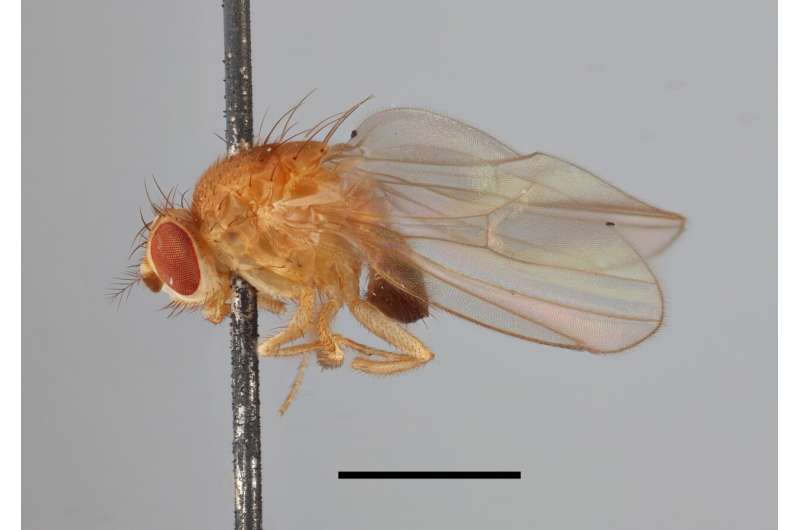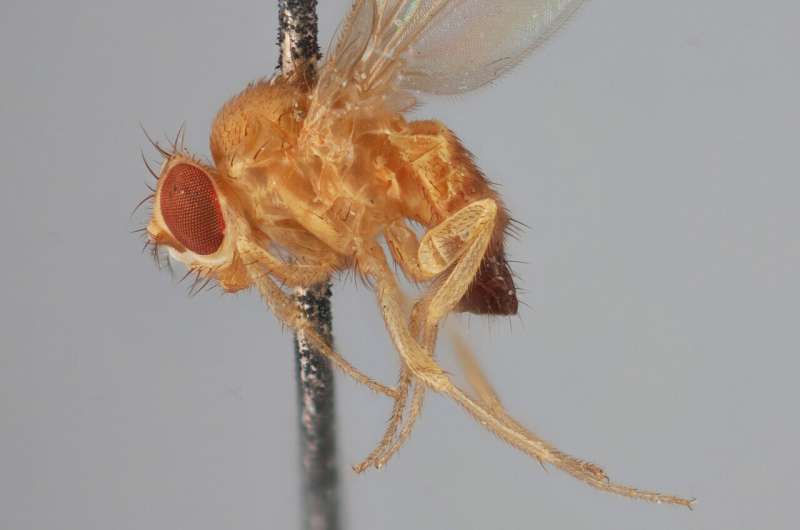This article has been reviewed according to Science X's editorial process and policies. Editors have highlighted the following attributes while ensuring the content's credibility:
fact-checked
peer-reviewed publication
trusted source
proofread
200-year-old DNA helps map tiny fly's genetic course to new lands, modern times

When Carl Fredrik Fallén, for one—and later Johan Wilhelm Zetterstedt—were collecting insects for what would become Lund University's entomological collections, they wondered exactly what was that buzzing coming from their can of raisins.
Skip forward 200 years, and the humble fruit fly, known better to geneticists as Drosophila melanogaster, is one of the most thoroughly studied animals on the planet. DNA from Fallén and Zetterstedt's centuries-old curiosities is still revealing new insights into the fly's evolution as it spread alongside people to new parts of the world.
Researchers from the University of Wisconsin–Madison and Lund University extracted and analyzed DNA from fruit flies housed in museum collections in Lund, Stockholm and Copenhagen. The flies are museum specimens collected by naturalists in Europe as early as the first decade of the 19th century and as recently as the 1930s.
The early fly-finders considered any insects they could get their hands on worth keeping—Fallén's specimens indeed include some that appear to have been enjoying his raisins—but they probably couldn't have conceived of Drosophila's importance to science.
"This species has been a key player in basic biological science for well over a century now," says John Pool, UW–Madison professor of genetics. "We've turned to it to learn things about the basic rules of life, what genetic variation looks like in natural populations, how different evolutionary forces shape diversity. And that's just in my field."
That means the genes of fruit flies may have been sequenced, catalogued and described more often than any other animal. But those samples came from modern specimens. Because a fruit fly lives about 50 days, the new DNA samples—described in a study published today in the journal PLOS Biology—come from some very ancient relatives of the flies buzzing around our fruit bowls these days.
"It's not so unusual to get useful DNA from very old specimens of our hominid ancestors or other animals," Pool says. "But the number of generations—about 3,000—that have elapsed in fly populations since some of these we've sequenced were alive is about the same number of our generations since humans emerged from Africa."
Lund zoologist Marcus Stensmyr recovered genetic material from the museum flies by soaking them in a solution that breaks open cell membranes to free up large molecules inside. The flies were washed and dried and returned to the museum collection. Their DNA was extracted from the solution and analyzed at UW–Madison.
Surprisingly, the researchers found the fruit flies collected in Sweden in the early 1800s were more genetically similar to 21st-century flies than the Swedish samples from the 1930s. That's likely due to the older flies' place in Drosophila history as some of the first arrivals so far north of their original range in Southern Africa. For some time, they were a small outpost, in which random mutations would make larger differences in the population—more of what's called "genetic drift"—as the 1800s became the 1900s. Swedish flies would get less unique, though, when their numbers were reinforced from the broader European gene pool.

"There would have been a vast increase in fruit shipping between the 1930s and the present and, generally, more human transport that probably increased opportunities for longer distance Drosophila migration," Pool says. "So, what we think we are seeing between the 1930s and the present is the effect of that migration basically homogenizing genetic variation."
By comparing changes across the centuries of fly samples now at their disposal, the researchers also identified a handful of genes showing signs of evolutionary pressure.
"That was a key interest of our study, to try to figure out which genes may have been the most important in helping this fly population adapt to very novel climate and a novel environment," Pool says.
Differences between DNA from 1930s specimens and their present-day kin revealed the emergence of a gene called Cyp6g1 that's known now to make the flies more resistant to the pesticide DDT.
"That was our top result for the more recent time interval," Pool says. "And that made perfect sense, in terms of when DDT was introduced."
That would be in the 1940s, not long after the study's most recent museum sources of Drosophila were still airborne. Earlier than that, important genetic shifts show a gene called Ahcy aiding the 19th century flies' adaptation to cooler temperatures and shorter days—important factors in the fly's reproductive cycles—in Sweden (and other high-latitude homes).
Another gene, ChKov1, was thought to be insecticide-related, but DNA from museum flies collected in the 1800s showed that the gene evolved before the relevant insecticides were even invented. Previous work by other researchers had suggested ChKov1 also conferred resistance to a virus, called sigmavirus, believed to have appeared in flies about 200 years ago.
"Our results strongly favor the viral resistance hypothesis over the insecticide resistance hypothesis," Pool says. "So, that's an example of a gene that was already suggested to be under natural selection, but we learned some new things about it by having these temporal samples."
It's a testament to both the work done long ago by curious scientists breaking new ground in their field and present-day practitioners using modern technology to much the same effect.
"This is an example of what millions of museum specimens all around the world could tell us about the changes that have taken place in many different species," says Pool.
More information: Max Shpak et al, Genomes from historical Drosophila melanogaster specimens illuminate adaptive and demographic changes across more than 200 years of evolution, PLOS Biology (2023). DOI: 10.1371/journal.pbio.3002333
Journal information: PLoS Biology
Provided by University of Wisconsin-Madison





















